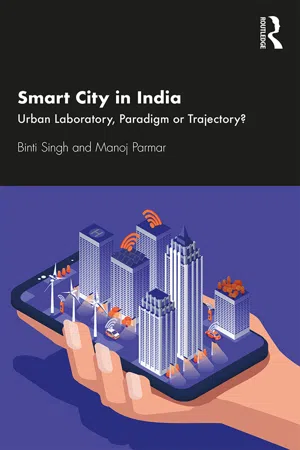
- 108 pages
- English
- ePUB (mobile friendly)
- Available on iOS & Android
About This Book
This book is a critical reflection on the Smart City Mission in India. Drawing on ethnographic data from across Indian cities, this volume assesses the transformative possibilities and limitations of the program. It examines the ten core infrastructural elements that make up a city, including water, electricity, waste, mobility, housing, environment, health, and education, and lays down the basic tenets of urban policy in India. The volume underlines the need to recognize liminal spaces and the plans to make the 'smart city' an inclusive one. The authors also look at maintaining a link between the older heritage of a city and the emerging urban space.
This volume will be of great interest to planners, urbanists, and policymakers, as well as scholars and researchers of urban studies and planning, architecture, and sociology and social anthropology.
Frequently asked questions
Information
FOREWORD 1

Professor of Urban Design
Department of Architecture
University of Strathclyde
Glasgow, United Kingdom
FOREWORD 2
Nagpur Smart and Sustainable City Development Corporation Ltd.,
Nagpur, India
ABBREVIATIONS
| ABD | Area-Based Development |
| AI | Artificial Intelligence |
| AMRUT | Atal Mission for Rejuvenation and Urban Transformation |
| ANPR | Automatic Number Plate Recognition |
| ANVP | Atal Nagar Vikas Pradhikaran |
| APEDA | Agricultural and Processes Food Products Export Development Authority |
| ASI | Archaeological Survey of India |
| BHU | Banaras Hindu University |
| BOT | Built–Operate–Transfer |
| BRTS | Bus Rapid Transit System |
| CBO | Community-Based Organization |
| CCTV | Closed-Circuit Television |
| CEO | Chief Executive Officer |
| CSR | Corporate Social Responsibility |
| DPRs | Detail Project Reports |
| ELU | Existing Land Use |
| FY | Financial Year |
| GDP | Gross Domestic P... |
Table of contents
- Cover
- Half Title
- Title
- Copyright
- Dedication
- CONTENTS
- List of figures
- List of boxes
- Foreword 1
- Foreword 2
- Abbreviations
- 1 Introduction
- 2 Smart City Mission in India
- 3 Packing history and culture with smartness: the cases of Lucknow and Varanasi
- 4 Urbanism, urban design, and planned historic cities
- 5 Reimagining the planning paradigm in India
- 6 Conclusion
- Index